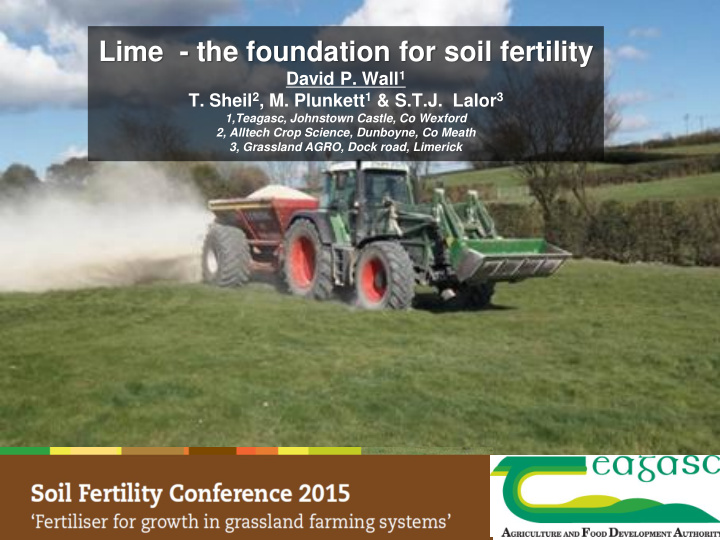



Lime - the foundation for soil fertility David P. Wall 1 T. Sheil 2 , M. Plunkett 1 & S.T.J. Lalor 3 1,Teagasc, Johnstown Castle, Co Wexford 2, Alltech Crop Science, Dunboyne, Co Meath 3, Grassland AGRO, Dock road, Limerick
What is soil pH? • Soil pH is the single most important chemical property of the soil (like soil texture is to the physical properties) • pH is a measure of hydrogen ion concentration (H + ) soil solution. • The pH scale ranges from 0 to 14, where 7 is considered neutral 1 2 3 4 5 6 7 8 9 10 11 12 13 14 Alkaline Neutral Acid Typical pH range for Irish soils • The pH scale is exponential pH 6 is 10X more acidic than pH 7 pH 5 is 100x more acid than pH 7 Therefore every 0.1 pH drop is a significant Wall, D.P. et al. Teagasc, Soil Fertility Conference, 2015
What effect does too much acidity have? Plant root injury:(H + & Al 3 + ) • changes in root membrane permeability • leakiness or loss of organic substrates & absorbed cations • + availability which is toxic to plant roots) Increases Al 3 • root tips can die and lateral root development is supressed Plant tops: - reduced transport of nutrients from roots
Effect of soil pH on soil P availability Phosphorus Fixation High Plant Available P Med Fixation by Fixation Iron & by Aluminium Calcium Low ` 3 4 5 6 7 8 9 Soil pH D.P. Wall, 2015 Acidic Soils Alkaline Soils Wall, D.P. et al. Teagasc, Soil Fertility Conference, 2015
Why is lime important ? Neutralises acidity to correct soil pH Supplies essential plant nutrients Ca (and Mg) Enhances soil biology and fertility • Organic activity in soil depends on soil pH • Release of nutrients from organic matter in soil • Optimises nutrient availability (stored and freshly applied nutrients) Wall, D.P. et al. Teagasc, Soil Fertility Conference, 2015
Tonnage of Lime ('000 t/yr) 1000 1500 2000 500 0 1970 1971 1972 1973 1974 1975 1976 1977 1978 1979 Lime usage 1970 -2014 1980 Wall, D.P. et al. Teagasc, Soil Fertility Conference, 2015 1981 1982 1983 1984 1985 1986 1987 1988 1989 1990 Year 1991 1992 1993 1994 1995 1996 1997 1998 1999 2000 2001 2002 2003 2004 2005 2006 2007 2008 2009 2010 2011 2012 2013 2014
Main lime sources available Lime CaCO 3 + Acid 2H + = Calcium Ca +2 + CarbonDioxide CO 2 + Water H 2 O 1. Ground Limestone (60% carbonate CaCO 3 ) • Finely ground to react with soils • (35%) <0.15mm & (65%) <3.35mm 2. Magnesium Limestone (40% MgCO3 60%CaC03 = 64.5% carbonate) • Higher neutralising value /slower to react / Use on Mg deficiency soils 3. Granulated Liming Products • Seasonal soil pH regulation / Similar to Fertilisers 4. Burnt Lime (CaO ) • Reacts faster?. 5. Hydrated lime (Ca (OH 2 )) • Reacts very rapid.
Ground limestone effect on soil pH Grazed grassland with 200kg N fertiliser 6.6 6.4 Target pH range 6.2 Soil pH level 6.0 5.8 5.6 5.4 5.2 5.0 1 6 12 18 24 30 36 42 Lime D.P. Wall et al., 2015 Months after application Applied Spring ‘11 Wall, D.P. et al. Teagasc, Soil Fertility Conference, 2015
Ground limestone effect on soil P levels Grazed grassland with 200kg N fertiliser 10 9 Soil test P (mg/L) 8 7 6 5 4 3 1 6 12 18 24 30 36 42 Lime D.P. Wall et al., 2015 Months after application Applied Spring ‘11 Wall, D.P. et al. Teagasc, Soil Fertility Conference, 2015
Efficiency of Bag Lime Products Ground limestone 7.5 t/ha Calcium oxide 2.5 t/ha (1:3 ratio) 6.5 Granulated Lime 2.5 t/ha (1:3 ratio) Control 6.0 Soil pH level Ground limestone 5.5 Calcium Oxide Granulated Lime 5.0 4.5 12 24 36 42 D.P. Wall et al., 2015 Months after application Wall, D.P. et al. Teagasc, Soil Fertility Conference, 2015
Effect of P and Lime of soil P availability Sheil, Wall & Lalor, 2015, FAI Wall, D.P. et al. Teagasc, Soil Fertility Conference, 2015
Effect of Lime on Aluminium availability Average change in soil test P across 16 200 Irish soils at 12 months after application Change in soil Aluminium Sheil, Wall & Lalor, 150 2015, FAI 100 Al 3+ (mg/kg) 50 0 -50 -100 -150 -200 -250 Control Lime Only P only P & Lime Treatments applied to soil * Increasing soil pH (less acidity) decreases available Al concentrations and reduces Al-P bonding (fixation) Wall, D.P. et al. Teagasc, Soil Fertility Conference, 2015
Effect of P and Lime of grass yield Average response across 2 sites D.P. Wall et al., 2015 Average soil pH: 5.2 6.4 5.2 6.4 Wall, D.P. et al. Teagasc, Soil Fertility Conference, 2015
Lime - Best Management Practice • Target mineral soils is pH of 6.3 for grassland ( for peats pH 5.5 ) • Apply lime based on the soil test report • Split lime applications when required rates exceed 7.5 t/ha • Caution! reduce lime rates on high molybdenum (Mo) soils so that pH does not exceed 6.2. • Ground limestone is the most cost effective source of lime and can be applied throughout the year when the opportunity arises. • As a rule of thumb: leave ≥3months between lime application and following with Urea or slurry application • Maintaining soil pH at the target level will increase the release of soil nutrients. • Lime is the foundation of soil fertility and is a primary step to take following soil sampling. Wall, D.P. et al. Teagasc, Soil Fertility Conference, 2015
Recommend
More recommend